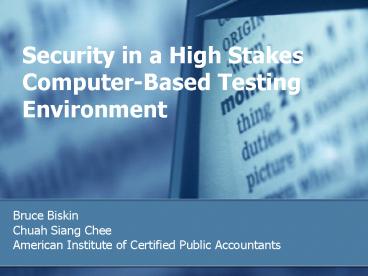Security in a High Stakes ComputerBased Testing Environment PowerPoint PPT Presentation
1 / 19
Title: Security in a High Stakes ComputerBased Testing Environment
1
Security in a High Stakes Computer-Based Testing
Environment
- Bruce Biskin
- Chuah Siang Chee
- American Institute of Certified Public Accountants
2
Uniform CPA Examination
- Has been produced by the American Institute of
Certified Public Accountants (AICPA) since 1917. - Used for licensing certified public accountants
in the US by all 54 boards of accountancy since
1968. - High Stakes Test
- Since April 2004, the CPA Exam has been
administered by computer at over 400 secure
testing centers.
3
Test Security
- Security is a concern with any high stakes test.
- Paper-based program had its own set of risks
- theft of booklets along the distribution path
from printing to scoring - copying at the testing centers
- CBT has its own set of risks
- candidates who test early could memorize test
material and make this information available to
candidates testing later
4
CBT Vs Paper-and-Pencil
- CBT
- Continuous Testing Window
- Secure computer systems allow for almost
instantaneous deployment - Encrypted Test Materials
- Exposure of items can be controlled
- Paper-Pencil
- Single administration of test form
- Transportation of items
- Forms can be lost/stolen
- Test items predetermined
5
Two Programs to Detect Security Breaches
- Crawling the Web for Bad Behavior
- Data forensics for Security Leaks
6
Crawling the Web for Bad Behavior
- Internet has provided an unprecedented capability
for making information available almost instantly
to millions of people at an extremely low cost. - The main goals were to determine whether actual
Exam content was being posted, offered, sold, or
shared - on Web sites
- in public and semi-public discussion groups
- in cyber-markets such as e-bay.
7
Cost
- Web crawling can be very expensive.
- Cost must be weighed against the potential cost
of failure to identify possible security breaches
in a timely manner. - Costs are monetary and political, and can impact
the credibility of the exam program. - The Web-crawling strategy them should be based on
risk and cost-benefit analyses. - Prioritize activities and constrain scope.
- Conduct work in-house or by contract.
8
Potential Benefits
- True Positives can result in
- Reduced financial and political impact of exposed
exam material. - Improved credibility of exam program.
- Maximum validity of decisions based on scores.
- True Negatives can result in
- Maximum confidence in fairness of exam.
9
Potential Costs
- False positives can result in
- High follow-up costs
- Potential legal exposure for false accusation or
damages if credentialing delayed - Ill-will of stakeholders
- Decreased validity of scores for decision-making
- False negatives can result in
- Perceptions of unfairness by stakeholders
- Decreased validity of scores for decision-making
10
Base Rates
- Higher incidence of Web-based events will result
in higher tangible return on investment - Lower need to replace exam materials through
early detection - Demonstrated ability to detect Web-based
eventsand publicizing actions takenmay
discourage additional events - Lower incidence of Web-based events will result
in higher intangible return on investment - Greater confidence in the integrity of examinees
and the associated practice of credential
holders, but - Cost per detected incidentif any--may be very
high
11
Recommendations
- Estimate costs of Web-crawling activities
- Identify resources (internal and external)
- Identify risks and benefits
- When using external resources
- Identify vendors
- Check the scope of services
- Check references
- Ask about quality of service
- Ask about costs vs. benefits
- Match your needs with those of references
12
Data Forensics for Security Leaks
- Another strategy is to identify and evaluate
changes in statistical characteristics of test
material, which can signal possible security
breaches. - Procedures can be as simple as looking for
unusual changes item difficulty within and across
testing windows, or identifying regional shifts
in item characteristics. They may also be
complex, involving fitting individual (or groups
of individual) test-taker response patterns to
models of aberrant responding.
13
IRT
- Given ability/Theta we can estimate the
probability of an examinee getting an item
correct. - 3-Parameter Logistic Model
- P(?) is the probability of a correct response
given ability/theta - D is a scaling constant equal to 1.702
- a, b, and c are the parameters characterizing an
item.
14
Estimating the Expected P-value
- Compute the probability of a correct response for
each examinee, given ability/theta. - The average probability for a given item across
examinees should approximate the proportion of
examinees correctly answering the item.
15
Adjusting for Ability
- Natural fluctuations in the average ability of
examinees. - Minimize false positives.
- Compute the difference between expected and
real/observed p-value. - Difference score indicates if examinees are
performing above or below expectations. - Concerned if it is significantly above
expectations as it may indicate that cheating is
occurring.
16
Difficulty in Interpreting Results
- Even with corrections, there are some minor
fluctuations. - Use historical trend of item behavior.
- Keep in mind sample size when interpreting
results.
17
Sample Results
18
Conclusions
- Ignoring problem isnt going to help.
- Relatively simple system.
- Relatively inexpensive system.
19
Recommendations
- What do you do after you have flagged a suspect
item? Have clear policies and procedures - Automating the system so that it does not become
an organizational burden.

